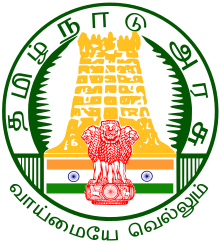Department of Environment and Forests
The Department of Environment and Forests is one of the departments of Government of Tamil Nadu. The department was created in 1995 and is responsible for environmental management and forests in the state.
 | |
| Agency overview | |
|---|---|
| Formed | 1995 |
| Jurisdiction | Tamil Nadu |
| Headquarters | Chennai |
| Ministers responsible |
|
| Agency executive |
|
| Parent agency | Government of Tamil Nadu |
| Website | Environment and Forests Department |
Forests
editTamil Nadu Forest Department is the nodal agency responsible for the protection and management of forests in the state.[1] Forests occupy an area of 22,643 km2 (8,743 sq mi) constituting 17.4% of the geographic area.[2] The state has varies forest ecosystems with the Western Ghats being one of the eight hottest biodiversity hotspots in the world and a UNESCO World Heritage Site.[3][4] There are about 2,000 species of wildlife that are native to Tamil Nadu and more than 5900 species of plants.[5]
The department is also responsible for the management of wildlife protection areas.[6] Protected areas cover an area of 3,305 km2 (1,276 sq mi), constituting 2.54% of the geographic area and 15% of the 22,643 km2 (8,743 sq mi) recorded forest area of the state.[2] Important ecological regions of Tamil Nadu are the Nilgiri Biosphere Reserve in the Nilgiri Hills, the Agasthyamala Biosphere Reserve in the Agastya Mala-Cardamom Hills and Gulf of Mannar coral reefs.[7] The state has five National Parks, 18 wildlife sanctuaries, five elephant sanctuaries as per Project Elephant, five tiger reserves as per Project Tiger and seventeen bird sanctuaries in Tamil Nadu.[8][9][10] There is one conservation reserve, two zoos recognised by the Central Zoo Authority of India and five crocodile farms.[11] The department also manages the Government Rubber Corporation, Tamil Nadu Forest Plantation Corporation Limited (TAFCORN), Tamil Nadu Tea Plantation Corporation (TANTEA) and Tamil Nadu Biodiversity Conservation And Greening Society (TNBCGS).[6]
Environment
editThe Environment department is responsible for pollution control across various ecosystems through the Tamil Nadu Pollution Control Board.[12] The department formulates policies to mitigate the impact of pollution in water bodies, control of air and noise pollution, climate change adaptation and coastal regulation.[12]
See also
editReferences
edit- ^ "Environment and Forests department". Government of Tamil Nadu. Retrieved 1 December 2023.
- ^ a b "Forest Wildlife resources". Government of Tamil Nadu. Retrieved 1 February 2023.
- ^ "Western Ghats". UNESCO. Retrieved 21 February 2014.
- ^ South Western Ghats montane rain forests (PDF) (Report). Ecological Restoration Alliance. Retrieved 15 April 2006.
- ^ "Forests of Tamil Nadu". ENVIS. Retrieved 1 December 2023.
- ^ a b "Forests department policy note 2023-24" (PDF). Government of Tamil Nadu. Retrieved 1 December 2023.
- ^ Biosphere Reserves in India (PDF) (Report). Ministry of Environment, Forest and Climate Change. 2019. Retrieved 5 February 2020.
- ^ Panwar, H. S. (1987). Project Tiger: The reserves, the tigers, and their future. Noyes Publications, Park Ridge, N.J. pp. 110–117. ISBN 978-0-8155-1133-5.
- ^ "Project Elephant Status". Times of India. 2 February 2009. Retrieved 24 February 2009.
- ^ "Bio-Diversity and Wild Life in Tamil Nadu". ENVIS. Retrieved 15 March 2018.
- ^ "Guindy Children's Park upgraded to medium zoo". The New Indian Express. 28 July 2022. Retrieved 31 October 2022.
- ^ a b "Environment department policy note 2023-24" (PDF). Government of Tamil Nadu. Retrieved 1 December 2023.